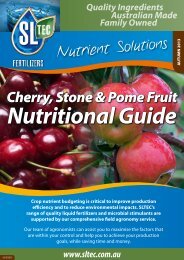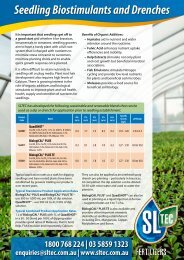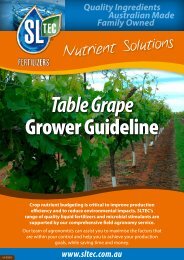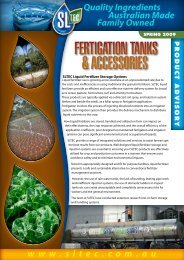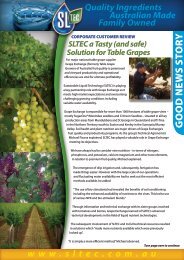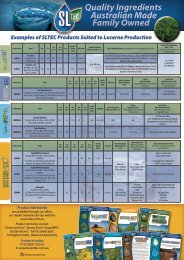Broadacre Nutritional Guide - Sustainable Liquid Technology
Broadacre Nutritional Guide - Sustainable Liquid Technology
Broadacre Nutritional Guide - Sustainable Liquid Technology
You also want an ePaper? Increase the reach of your titles
YUMPU automatically turns print PDFs into web optimized ePapers that Google loves.
Manganese (Mn) is classified as a micro nutrient, even thoughit’s required by the plant in greater quantities than Cu and Zn. Itis actively absorbed and this is enhanced in soil with pH 4.5 to 5.5.Manganese is relatively immobile within the plant and is transportedto the apical meristem via the xylem.Manganese is associated with Mg in many of its roles. It acts asan energy catalyst and is heavily involved in the production ofchlorophyll. Manganese accelerates germination and seedlinggrowth, it is involved in the formation of vitamins and combines withPhosphorous to form enzymes.Zinc (Zn) is actively taken up by the plant. This takes place in greateramounts that Cu and less than Mn. Like P, Zn uptake is increased withthe symbiotic relationship with VAM in cereal crops. Zinc absorbsionis greatly reduced in low temperatures and by the inhibition by otherelements. Copper and Phosphorous are strong competitors for thesame carrier sites, while Mg, Fe, and Mn can all depress the uptake ofZn.Zinc with Ca is essential in the production of auxins (growthhormones) along with other essential enzymes. Along with K it hasa regulatory role in the uptake and transportation of water withinthe plant. Zinc is also required for chlorophyll production, proteinsynthesis, seed production as well as height and length of plants.Copper (Cu) is actively taken up by plants and is able to displaceother ions from root exchange sites. It is mobile within the plant andyet its movement is governed by uptake and availability. Meaning,if availability is poor, and uptake is low, Cu movement is restricted,even if the reproductive parts are requiring it. Copper is an integralcomponent of chloroplasts and hence is involved in photosynthesis.It is essential for the formation of enzymes which are involved inrespiration, energy and growth.Boron (B) is only required by plants in very small amounts. It seemsto be both passive and active in its uptake mechanism. Similarlywith Ca, Boron is quite immobile within the plant and only seemsto move in the xylem towards the growing points. Boron has someassociation with auxins, synthesis and movement of sugars, is involvedin the production of carbohydrates and Nitrate reduction. It is alsoextremely necessary for the germination and viability of pollen, seedquality and yield.Without Boron the plant struggles to utilise essential nutrients like Ca,N, and P, therefore, there is a reduction in new tissue development.Iron (Fe) uptake seems to be controlled by metabolic processes. Itappears that it is mainly absorbed through the root tips. It is inhibitedby the uptake of other cations such as; Mn, Cu, Mg, K and Zn. Due toFe immobility within the plant, young plant tissue requires a constantsupply. The main function of Fe within plants is in the production ofChlorophyll and it acts as a catalyst to carry Oxygen in leaf parts forchlorophyll synthesis.Molybdenum (Mo) uptake is similar to Fe. It is controlled bymetabolic processes and yet uptake seems active. Molybdenum isinvolved in two major enzymes; Nitrate reductase and Nitrogenase,which is involved in Nitrogen fixation by legumes along with Fe andCobalt. Molybdenum uptake is inhibited by high Cu and especially Mnand Aluminum in low pH soils.Why Tissue Test?Plant tissue analysis acts as an early warning system to highlight any nutrients that may become either deficient toxic beforethey display any visible symptoms, or which may affect crop yield and quality. Monitoring plants’ uptake of nutrients andunderstanding soil nutrition provides growers with management tools that are likely to improve profitability and the long-termviability of their enterprise.Wheat Nutrient Levels - YFEL + 2 (GS. Z15 - 30): Youngest Fully Expanded Leaf + the Next Two Youngest LeavesNutrientLevel N % S % P % K % Ca % Mg % Na % Cl %Excessive > 6.5 > 0.4 > 0.7 > 6.0 > 0.7 > 0.3 > 1.0 > 3.0 > 50.0 > 60.0 > 700.0 > 100.0 > 30.0 > 0.6 > 200.0Optimum3.5 -5.50.15 -0.40.3 -0.52.4 -4.00.21 -0.40.13 -0.30.5 -1.0Deficient < 3.4 < 0.15 < 0.24 < 1.5 < 0.18 < 0.11 - - < 2.0 < 14.0 < 12.0 < 25.0 < 2.0 < 0.05 -Reference: Weir R.G. & Cresswell G.C. - “Plant Nutrient Disorders 4, Pastures and Field Crops” (1994)Canola Nutrient Levels - YML (Pre-Flowering): Youngest Mature LeafNutrientLevel N % S % P % K % Ca % Mg % Na % Cl %Excessive > 5.6 > 1.0 > 0.65 > 6.5 > 3.0 > 0.65 > 0.7 > 2.0 >25.0 > 55.0 > 300.0 - > 50.0 > 1.6 -Optimum3.5 -5.50.6 -1.00.35 -0.62.8 -5.51.4 -3.00.21 -0.650.02 -0.5Deficient < 2.7 < 0.5 < 0.29 < 1.9 0.8 - 1.2 < 0.19 < 0.02 < 0.4 < 3.0 < 17.0 < 30.0 - < 20.0 < 0.28 -Reference: Weir R.G. & Cresswell G.C. - “Plant Nutrient Disorders 4, Pastures and Field Crops” (1994)1.9 -2.00.4 -1.6Cu(mg/kg)5.0 -50.0Cu(mg/kg)4.0 -25.0Zn(mg/Kg)20.0 -60.0Zn(mg/Kg)21.0 -55.0Mn(mg/Kg)25.0 -300.0Mn(mg/Kg)30.0 -250.0Fe(mg/Kg)25.0 -100.0Fe(mg/Kg)-B(mg/Kg)5.0 -10.0B(mg/Kg)22.0 -50.0Mo(mg/Kg)0.1 -0.5Mo(mg/Kg)0.28 -0.55Al(mg/Kg)< 200.0Al(mg/Kg)-11



